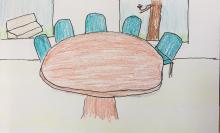April 5, 2016 - 09:45
Righting Wrongs, Wronging Wrongs, and Restoration
My connection to this Glossary of Haunting came through my involvement with restorative justice. In being a member of the Bryn Mawr College Honor Board, I was able to experience restorative justice in action. Instead of attempting to right wrongs, restorative justice aims to heal individuals and communities. This may not look the same as the "revenge" Tuck & Ree discuss, but it acknowledges the damage and hurt that have been caused, rather than attempting to ignore them. A restorative justice model may not work to heal years of colonialism and settelor violences, and not much may, but it is certainly an approach that can work for individuals with relationships that can be repaired and built upon.
I would like to see more of a restorative justice approach in my field placement, rather than the complete lack of facilitated justice that I see now. In classrooms where the students have relationships with one another, incidences of hurt can function as learning opportunities and opportunities for relationship building, but the hurt has to be acknowledged. When teachers ignore the hurt feelings of their students, they miss an opportunity to invite other students to find healing with them. They miss an opportunity to be empowering learners, as the enquire into their student's pain and damage.

